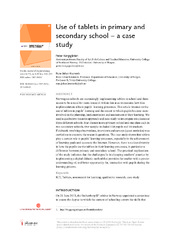Use of tablets in primary and secondary school – a case study
Peer reviewed, Journal article
Published version

Åpne
Permanent lenke
https://hdl.handle.net/1956/19272Utgivelsesdato
2016Metadata
Vis full innførselSamlinger
- Department of Education [296]
Originalversjon
https://doi.org/10.18261/issn.1891-943x-2016-04-03Sammendrag
Norwegian schools are increasingly implementing tablets in school and there seems to be a need for more research within this area to examine how this implementation affects pupils’ learning processes. This article focuses on the use of tablets in pupils’ learning and the extent to which pupils become more involved in the planning, implementation and assessment of their learning. We used a qualitative research approach and case study to investigate six classes at three different schools: four classes in one primary school and one class each in two secondary schools. Our sample included 134 pupils and 14 teachers. Fieldwork involving observations, interviews and surveys (quasi statistics) was carried out to examine the research questions. The case study shows that tablets play a certain role in pupils’ learning processes, especially in the achievement of learning goals and access to the Internet. However, there is a clear diversity in how the pupils use the tablets in their learning processes, in particular a difference between primary and secondary school. The practical implications of the study indicates that the challenges lie in changing teachers’ practice by implementing a digital didactic method that provides the teacher with a greater understanding of, and better opportunity for, interaction with pupils during the learning process.
